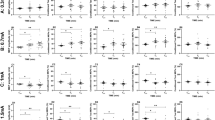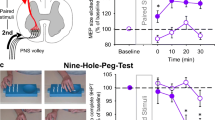Abstract
Noninvasive transspinal stimulation of the thoracolumbar region, where leg motor circuits reside, produces prominent plasticity of brain and spinal cord circuits. However, reorganization of cortical and corticospinal excitability after multiple sessions (i.e. repeated) remains elusive. In this study, we investigated changes in intracortical inhibition, intracortical facilitation, and corticospinal excitability after 10 sessions of cathodal transcutaneous delivery of pulse or direct current stimulation, termed here transspinal (tsPCS, tsDCS), in resting healthy humans. tsPCS was delivered at sub- and supra-threshold intensities, while intensity for tsDCS ranged from 2.24 to 2.34 mA within a session. Intracortical inhibition and facilitation were assessed based on the tibialis anterior (TA) motor evoked potential (MEP) amplitude following subthreshold transcranial magnetic stimulation (TMS) at the conditioning-test (C-T) intervals of 1, 2, 3, 10, 15, 20, 25, and 30 ms. The TA MEP recruitment input–output curves were also assembled to establish changes in corticospinal excitability. For both transspinal stimulation protocols, the active cathodal electrode was placed over the T10 spinal process. Results indicated that repeated tsPCS did not alter intracortical inhibition or intracortical facilitation but decreased corticospinal excitability for the right M1 and increased corticospinal excitability for the left M1. tsDCS decreased intracortical inhibition, increased intracortical facilitation, did not affect the maximal MEP amplitude but increased the slope of the right TA MEP input–output curve. Neurophysiological changes may be attributed to neural mechanisms involved in learning and memory. These results support that noninvasive transspinal stimulation alters both cortical and corticospinal neural excitability in resting healthy humans.





Similar content being viewed by others
References
Aguilar J, Pulecchi F, Dilena R, Oliviero A, Priori A, Foffani G (2011) Spinal direct current stimulation modulates the activity of gracile nucleus and primary somatosensory cortex in anaesthetized rats. J Physiol 589:4981–4996
Ahmed Z (2011) Trans-spinal direct current stimulation modulates motor cortex-induced muscle contraction in mice. J Appl Physiol 110:1414–1424
Ahmed Z, Wieraszko A (2012) Trans-spinal direct current enhances corticospinal output and stimulation-evoked release of glutamate analog, D-2,3-3H-aspartic acid. J Appl Physiol 112:1576–1592
Ardolino G, Bossi B, Barbieri S, Priori A (2005) Non-synaptic mechanisms underlie the after-effects of cathodal transcutaneous direct current stimulation of the human brain. J Physiol 568:653–663
Arvanian VL, Mendell LM (2001) Removal of NMDA receptor Mg(2+) block extends the action of NT-3 on synaptic transmission in neonatal rat motoneurons. J Neurophysiol 86:123–129
Arvanian VL, Bowers WJ, Petruska JC, Motin V, Manuzon H, Narrow WC, Federoff HJ, Mendell LM (2004) Viral delivery of NR2D subunits reduces Mg2+ block of NMDA receptor and restores NT-3-induced potentiation of AMPA-kainate responses in maturing rat motoneurons. J Neurophysiol 92:2394–2404
Arvanov VL, Seebach BS, Mendell LM (2000) NT-3 evokes an LTP-like facilitation of AMPA/kainate receptor-mediated synaptic transmission in the neonatal rat spinal cord. J Neurophysiol 84:752–758
Batsikadze G, Moliadze V, Paulus W, Kuo MF, Nitsche MA (2013) Partially non-linear stimulation intensity-dependent effects of direct current stimulation on motor cortex excitability in humans. J Physiol 591:1987–2000
Bennett MR (2000) The concept of long term potentiation of transmission at synapses. Prog Neurobiol 60:109–137
Bikson M, Inoue M, Akiyama H, Deans JK, Fox JE, Miyakawa H, Jefferys JG (2004) Effects of uniform extracellular DC electric fields on excitability in rat hippocampal slices in vitro. J Physiol 557:175–190
Bindman LJ, Lippold OC, Redfearn JW (1962) Long-lasting changes in the level of the electrical activity of the cerebral cortex produced by polarizing currents. Nature 196:584–585
Bindman LJ, Lippold OC, Redfearn JW (1964) The action of brief polarizing currents on the cerebral cortex of the rat (1) during current flow and (2) in the production of long-lasting after-effects. J Physiol 172:369–382
Bocci T, Vannini B, Torzini A, Mazzatenta A, Vergari M, Cogiamanian F, Priori A, Sartucci F (2014) Cathodal transcutaneous spinal direct current stimulation (tsDCS) improves motor unit recruitment in healthy subjects. Neurosci Lett 578:75–79
Bocci T, Barloscio D, Vergari M, Di Rollo A, Rossi S, Priori A, Sartucci F (2015a) Spinal direct current stimulation modulates short intracortical inhibition. Neuromodulation 18:686–693
Bocci T, Marceglia S, Vergari M, Cognetto V, Cogiamanian F, Sartucci F, Priori A (2015b) Transcutaneous spinal direct current stimulation modulates human corticospinal system excitability. J Neurophysiol 114:440–446
Bocci T, Caleo M, Vannini B, Vergari M, Cogiamanian F, Rossi S, Priori A, Sartucci F (2015c) An unexpected target of spinal direct current stimulation: interhemispheric connectivity in humans. J Neurosci Methods 254:18–26
Bolzoni F, Jankowska E (2015) Presynaptic and postsynaptic effects of local DC polarization within the spinal cord in anaesthetized animal preparations. J Physiol 593:947–966
Capaday C, Stein RB (1987) A method for simulating the reflex output of a motoneuron pool. J Neurosci Methods 21:91–104
Chen R, Tam A, Butefisch C, Corwell B, Ziemann U, Rothwell JC, Cohen LG (1998) Intracortical inhibition and facilitation in different representations of the human motor cortex. J Neurophysiol 80:2870–2881
Cogiamanian F, Vergari M, Pulecchi F, Marceglia S, Priori A (2008) Effect of spinal transcutaneous direct current stimulation on somatosensory evoked potentials in humans. Clin Neurophysiol 119:2636–2640
Cogiamanian F, Ardolino G, Vergari M, Ferrucci R, Ciocca M, Scelzo E, Barbieri S, Priori A (2012) Transcutaneous spinal direct current stimulation. Front Psychiatry 3:63
Dan Y, Poo MM (2004) Spike timing-dependent plasticity of neural circuits. Neuron 44:23–30
Devanne H, Lavoie BA, Capaday C (1997) Input–output properties and gain changes in the human corticospinal pathway. Exp Brain Res 114:329–338
Di Lazzaro V, Restuccia D, Oliviero A, Profice P, Ferrara L, Insola A, Mazzone P, Tonali P, Rothwell JC (1998) Magnetic transcranial stimulation at intensities below active motor threshold activates intracortical inhibitory circuits. Exp Brain Res 119:265–268
Dixon L, Ibrahim MM, Santora D, Knikou M (2016) Paired associative transspinal and transcortical stimulation produces plasticity in human cortical and spinal neuronal circuits. J Neurophysiol 116:904–916
Eccles JC (1987) Mechanisms of learning in complex neural systems. Supplement 5: handbook of physiology, the nervous system, higher functions of the brain. American Physiological Society, Bethsesda. https://doi.org/10.1002/cphy.cp010505
Eccles JC, Kostyuk PG, Schmidt RF (1962) The effect of electric polarization of the spinal cord on central afferent fibres and on their excitatory synaptic action. J Physiol 162:138–150
Fino E, Deniau JM, Venance L (2008) Cell-specific spike-timing-dependent plasticity in GABAergic and cholinergic interneurons in corticostriatal rat brain slices. J Physiol 586:265–282
Fritsch B, Reis J, Martinowich K, Schambra HM, Ji Y, Cohen LG, Lu B (2010) Direct current stimulation promotes BDNF-dependent synaptic plasticity: potential implications for motor learning. Neuron 66:198–204
Galea JM, Celnik P (2009) Brain polarization enhances the formation and retention of motor memories. J Neurophysiol 102:294–301
Hanajima R, Ugawa Y, Terao Y, Enomoto H, Shiio Y, Mochizuki H, Furubayashi T, Uesugi H, Iwata NK, Kanazawa I (2002) Mechanisms of intracortical I-wave facilitation elicited with paired-pulse magnetic stimulation in humans. J Physiol 538:253–261
Houle JD, Côté MP (2013) Axon regeneration and exercise-dependent plasticity after spinal cord injury. Ann N Y Acad Sci 1279:154–163
Hunanyan AS, Petrosyan HA, Alessi V, Arvanian VL (2012) Repetitive spinal electromagnetic stimulation opens a window of synaptic plasticity in damaged spinal cord: role of NMDA receptors. J Neurophysiol 107:3027–3039
Ilic TV, Meintzschel F, Cleff U, Ruge D, Kessler KR, Ziemann U (2002) Short-interval paired-pulse inhibition and facilitation of human motor cortex: the dimension of stimulus intensity. J Physiol 545:153–167
Jankowska E, Kaczmarek D, Bolzoni F, Hammar I (2017) Long-lasting increase in axonal excitability after epidurally applied DC. J Neurophysiol 118:1210–1220
Jeftinija S, Urban L (1994) Repetitive stimulation induced potentiation of excitatory transmission in the rat dorsal horn: an in vitro study. J Neurophysiol 71:216–228
Kallioniemi E, Pääkkönen A, Julkunen P (2015) Repetition suppression in transcranial magnetic stimulation-induced motor-evoked potentials is modulated by cortical inhibition. Neuroscience 310:504–511
Knikou M (2013) Neurophysiological characterization of transpinal evoked potentials in human leg muscles. Bioelectromagnetics 34:630–640
Knikou M (2014) Transpinal and transcortical stimulation alter corticospinal excitability and increase spinal output. PLoS ONE 9:e102313. https://doi.org/10.1371/journal.pone.0102313
Knikou M, Murray LM (2018) Neural interactions between transspinal evoked potentials and muscle spindle afferents in humans. J Electromyogr Kinesiol 43:174–183
Knikou M, Dixon L, Santora D, Ibrahim MM (2015) Transspinal constant-current long-lasting stimulation: a new method to induce cortical and corticospinal plasticity. J Neurophysiol 114:1486–1499
Kujirai T, Caramia MD, Rothwell JC, Day BL, Thompson PD, Ferbert A, Wroe S, Asselman P, Marsden CD (1993) Corticocortical inhibition in human motor cortex. J Physiol 471:501–519
Lamy JC, Boakye M (2013) BDNF Val66Met polymorphism alters spinal DC stimulation-induced plasticity in humans. J Neurophysiol 110:109–116
Lim CY, Shin HI (2011) Noninvasive DC stimulation on neck changes MEP. NeuroReport 22:819–823
Malenka RC, Kauer JA, Zucker RS, Nicoll RA (1988) Postsynaptic calcium is sufficient for potentiation of hippocampal synaptic transmission. Science 242:81–84
McCreery DB, Agnew WF, Yuen TG, Bullara L (1990) Charge density and charge per phase as cofactors in neural injury induced by electrical stimulation. IEEE Trans Biomed Eng 37:996–1001
Müller-Dahlhaus F, Ziemann U, Classen J (2010) Plasticity resembling spike-timing dependent synaptic plasticity: the evidence in human cortex. Front Synaptic Neurosci 2:34. https://doi.org/10.3389/fnsyn.2010.00034
Murray LM, Knikou M (2017) Remodeling brain activity by repetitive cervicothoracic transspinal stimulation after human spinal cord injury. Front Neurol 8:50. https://doi.org/10.3389/fneur.2017.00050
Murray LM, Tahayori B, Knikou M (2018) Transspinal direct current stimulation produces persistent plasticity in human motor pathways. Sci Rep 8:717. https://doi.org/10.1038/s41598-017-18872-z
Murray LM, Islam MA, Knikou M (2019) Cortical and subcortical contributions to neuroplasticity after repetitive transspinal stimulation in humans. Neural Plast 2019:4750768. https://doi.org/10.1155/2019/4750768
Naka A, Gruber-Schoffnegger D, Sandkühler J (2013) Non-Hebbian plasticity at C-fiber synapses in rat spinal cord lamina I neurons. Pain 154:1333–1342
Nierat MC, Similowski T, Lamy JC (2014) Does trans-spinal direct current stimulation alter phrenic motoneurons and respiratory neuromechanical outputs in humans? A double-blind, sham-controlled, randomized, crossover study. J Neurosci 34:14420–14429
Pandey A, Sikdar SK (2014) Depression biased non-Hebbian spike-timing-dependent synaptic plasticity in the rat subiculum. J Physiol 592:3537–3557
Parazzini M, Fiocchi S, Liorni I, Rossi E, Cogiamanian F, Vergari M, Priori A, Ravazzani P (2014) Modeling the current density generated by transcutaneous spinal direct current stimulation (tsDCS). Clin Neurophysiol 125:2260–2270
Piochon C, Kruskal P, Maclean J, Hansel C (2013) Non-Hebbian spike-timing-dependent plasticity in cerebellar circuits. Front Neural Circuits 6:124. https://doi.org/10.3389/fncir.2012.00124
Priori A, Ciocca M, Parazzini M, Vergari M, Ferrucci R (2014) Transcranial cerebellar direct current stimulation and transcutaneous spinal cord direct current stimulation as innovative tools for neuroscientists. J Physiol 592:3345–3369
Sieber AR, Min R, Nevian T (2013) Non-Hebbian long-term potentiation of inhibitory synapses in the thalamus. J Neurosci 33:15675–15685
Vogels TP, Froemke RC, Doyon N, Gilson M, Haas JS, Liu R, Maffei A, Miller P, Wierenga CJ, Woodin MA, Zenke F, Sprekeler H (2013) Inhibitory synaptic plasticity: spike timing-dependence and putative network function. Front Neural Circuits 7:119. https://doi.org/10.3389/fncir.2013.00119
Wesselink WA, Holsheimer J, Boom HBK (1998) Analysis of current density and related parameters in spinal cord stimulation. IEEE Trans Rehabil Eng 6:200–207
Ziemann U, Rothwell JC, Ridding MC (1996) Interaction between intracortical inhibition and facilitation in human motor cortex. J Physiol 496:873–881
Acknowledgements
This work was supported by the Craig H. Neilsen Foundation (Grant no. 339705 awarded to Maria Knikou). The funder had no role in the design and conduct of the study, collection, management, analysis, and interpretation of the data; preparation, review, or approval of the manuscript; and decision to submit the manuscript for publication.
Author information
Authors and Affiliations
Corresponding author
Ethics declarations
Conflict of interest
The authors declare that they have no conflict of interest to report.
Additional information
Publisher's Note
Springer Nature remains neutral with regard to jurisdictional claims in published maps and institutional affiliations.
Rights and permissions
About this article
Cite this article
Murray, L.M., Knikou, M. Repeated cathodal transspinal pulse and direct current stimulation modulate cortical and corticospinal excitability differently in healthy humans. Exp Brain Res 237, 1841–1852 (2019). https://doi.org/10.1007/s00221-019-05559-2
Received:
Accepted:
Published:
Issue Date:
DOI: https://doi.org/10.1007/s00221-019-05559-2




